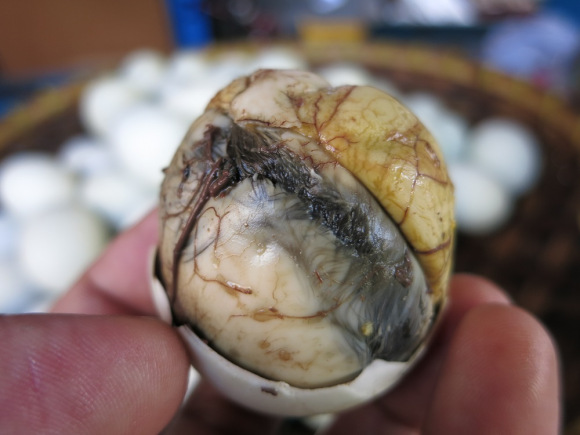
Surely, this has to be one of the most unique boiled eggs in the world. In case you can’t make it out properly, we ought to explain that this is a duck egg. With a duck embryo inside. And that strip of black there is indeed baby duck fur. It’s an image so frightful to some that eating it became a featured challenge on TV shows like Survivor and Fear Factor. To others, however, this is simply a delicious Filipino street delicacy.
Keeping an open mind, we plucked up the courage to try one of these babies (pun very much intended) while on a recent trip to the Philippines with one of our Filipino friends. But what did it taste like? And what does a whole baby duck feel like inside your mouth? We give you everything you need to know, complete with mouth-watering photos.
***Some readers may find the following images disturbing.***
What exactly is this frightening boiled egg?
It’s called balut. It’s a fertilised duck egg that’s boiled after being incubated for 10-20 days. Ducks can hatch anytime from the 21-day mark so you can imagine what kind of state these embryos are in. Beaks, feet, fur, bones, organs, all are in there waiting for you.
Where can you get them?
If you go to a street stall market in the Philippines, you’ll see these being sold everywhere. There’s a famous street stall market in Manila that sells everything you can think of, and here you can see young brothers and sisters preparing food at food stalls. This is where we got our balut, from a pile packed high on a bamboo tray. One for 32 peso or 32 yen (US$0.32).
How do you eat them?
1. Crack off the top of the shell
These things are easy to eat. Before you start, simply crack a hole in the top of the egg and then sprinkle a bit of salt and vinegar inside. Then drink up the soupy goodness inside from the shell. This was surprisingly delicious! It tasted like oyakodon, a popular (and totally unfrightening) Japanese chicken and egg dish.
2. Peel off most of the shell
Taking a quick look at it, it all looked a bit like brain tissue and you could clearly see blood vessels everywhere. But when we looked at it more closely, we could see feathers growing on the inside. Eating this would be a challenge for anyone. It was going to take quite a bit of courage to get this down.
3. Bite into it
Looking at the cross-section left after biting into it, we could see that we’d bitten into internal organs. The texture was like cartilage. The feathers got stuck in between our teeth. There was no way to describe the flavour. When asked if it was delicious or horrible, all we could muster around our mouthful of meat and baby organs was, “uhhm…”
Why eat Balut?
Although unimaginable to most of us, balut is eaten for nourishment and strength. To get the maximum benefits, they say you should eat two in one sitting. Hats off to the strong men out there eating two of these at a time!
How can I pick the best one?
If you’re going to take the challenge, you might as well try to pick the best of the bunch, right? The trick to picking balut is that the darker the shell, the higher the likelihood that the duckling inside was closer to being born. So the soup inside will taste like sazae (サザエ), a cooked turban shellfish, which is a delicacy in Japan.
Of course, there are other ways to eat this egg, other than the peel-and-eat method we’ve shown you here. The contents of the egg are sometimes made into omelettes or grilled on skewers and eaten. People in the Philippines can prepare this egg for you in many different ways. We must say, we’re always impressed by the ideas and creative originality we see whenever we visit the Philippines.
Our street vendors, a young brother and sister team who prepare food at their stall. Family bonds and affection are strong in the Philippines. And no, they’re not laughing at us, they’re laughing with us. We think.
While we may not be totally sold on this street stall delicacy, we’re all stronger and wiser from the experience! We love the Philippines and its people so hopefully we’ll be back again to try something new soon. Thank you for the balut!
Photos © SoraNews24
● Want to hear about SoraNews24’s latest articles as soon as they’re published? Follow us on Facebook and Twitter!